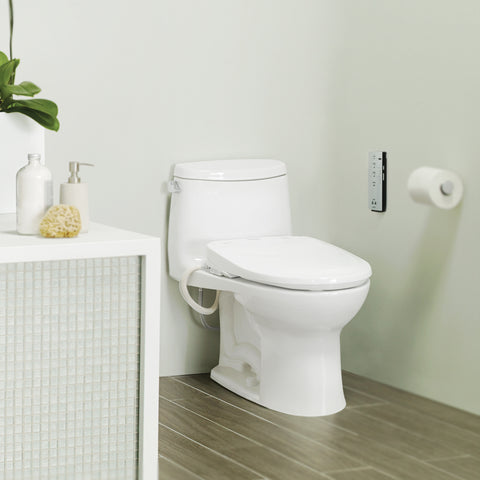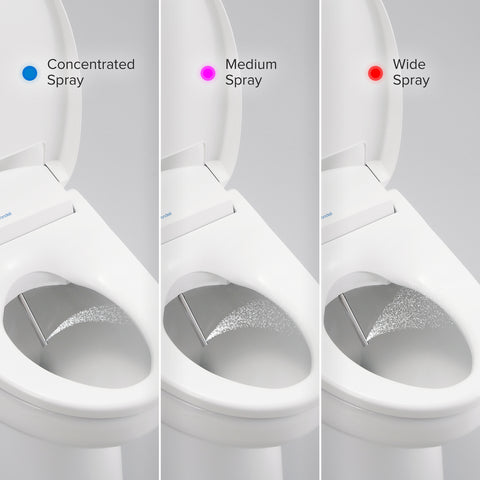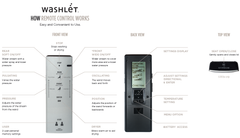What you Need to Know About Japanese Toilets
What you Need to Know About Japanese Toilets

Japanese toilets are all the rage in - you guessed it - Japan. When it comes to their presence in the U.S., though, they’re much less common.
This is one of the great unfortunate realities of the world. While the U.S. toilet seemed well and dandy until pretty recently, anyone who has ever used a bidet while traveling abroad can tell you that they’re a world better than their hand-and-paper counterparts.
Think about that for a minute - why would you use your hand and a crumpled-up wad of tree fiber to clean your derriere when you could be using warm water?
Called bidets, washlets, or simply Japanese toilets, these engineering wonders are everywhere throughout Japan, but are still gaining popularity in the U.S. Here’s everything you need to know about this unique invention:
What is a Japanese Toilet?
The defining part of a Japanese toilet is the seat. While the base and tank resemble the Western toilets most of us have been using for years, the seat is electronic and offers a built-in bidet function, which offers nozzles, a remote control or side-panel feature, and about twelve unique ways to wash your bum.
These toilet seats come with all the bells and whistles and are designed to offer everything you could want from a bidet, along with a few things you didn’t know you needed. For example, most Japanese toilets offer heated seats, automatic open lids, sensors designed to dry your bum automatically, brushed steel remote controls that look like something made by Bugatti, and more.
They’re magical devices, and they deserve a place in your bathroom. Have a thing against bidets? You don’t have to use the bidet feature of a Japanese toilet. The seats look, feel, and function exactly like any standard toilet seat.
The History of the Japanese Toilet
Japanese culture has a reputation for being one of the most fastidious cultures on earth, and rightfully so. Right now, upwards of 72% of Japanese households have a bidet-style toilet installed in the home.
This craze with cleanliness dates back centuries but started taking the form of super-fancy toilets around 1980, when Toto introduced the Washlet G Series. Today, most Japanese toilets are called washlets, although that’s technically a term that was coined by Toto. In recent years, however, it’s become a synonym for any bidet-style toilet seat used or sold in Japan.
If you’ve ever visited Japan, you’ve probably noticed that these toilets are everywhere. An upgrade to the traditional Japanese toilet, which involved squatting over a urinal, the new-age Japanese toilets offer a comfortable yet straightforward way to get squeaky-clean after a trip to the bathroom.
They’re also an upgrade to traditional bidet units, which sat separate of toilets and required users to hop off the toilet to use the bidet. Today, Japanese toilets are a convenient, all-in-one unit ideal for use in most spaces.
The 4 Biggest Benefits of a Japanese Toilet
If you’ve ever wondered about the benefits of a Japanese toilet, wonder no more. These handy units have all sorts of perks, including but not limited to the following:
-
They’re Easy to Install
While a Japanese toilet may sound like some fancy invention, it’s a very easy unit to install.
Even if you have a traditional toilet in your home right now, a Japanese toilet (or a bidet seat) is a simple, DIY installation project that will only take you about 30 minutes to swap out. This makes it accessible and fun for anyone who’s ever dreamed of having one.

-
They Clean Better Than Paper
Think about these two options: you could use a wad of rough paper to clean your bum after the go, or you could use a high-tech device that shoots a concentrated stream of warm water at your nether regions.
Which one sounds better? Which one do you think is more effective?
If you guessed warm water, you’re right. Not only is it soothing and relaxing, but it’s also just a better way to get clean than the alternative.
-
They’re Environmentally-Friendly
Japanese toilets are ultra-environmentally-friendly. Wondering why? Because they allow you to use less toilet paper and less water.
While you might not dedicate much thought to how many trees each roll of TP you use consumes, it takes about one tree to produce 100 pounds of toilet paper, and upwards of 83 million rolls of paper are generated daily. The global demand for toilet paper consumes 27,000 trees every day.
-
Japanese Toilets Offer Medical Benefits
In addition to being outstandingly pleasant and easy to install, Japanese toilets also offer a whole host of medical benefits.
In fact, that’s part of the most prominent reason they’re so popular in Japan and other health-conscious cultures. While dry-wiping doesn’t remove harmful and potentially infectious bacteria, using a bidet does.
Because bidets use water rather than friction to get you clean, they remove bacteria that can lead to inflammation, infections, and discomfort. In fact, a bidet reduces the risk of bacterial prostatitis (a condition that currently affects about 8% of all men) dramatically.
For women, bidets can also reduce urinary tract infections and quell some of the discomforts that come from wiping scar tissue caused by episiotomy or other procedures.
What to Look for in a Japanese Toilet
If you’re interested in installing a Japanese toilet in your home, you’re about to join a very prestigious (and clean) club. Here’s what you need to know about browsing the selection of Japanese Toilets and finding the right one for you:

-
Features
Japanese toilets have dozens of exciting features, and the key to finding the right one for you is simply to choose one that has the features you want in a toilet. These puppies require a remote - and you'll be so happy they do!
Depending on which model you’re looking into, you can easily find a unit that offers a heated seat, an automatically opening and closing lid, or even a lullaby feature to welcome you in the middle of the night.
Many of the features are more specific than those, though. For example, if you live in a household that includes both men and women, look for a bidet that offers a front and posterior nozzle that’s fully adjustable. This ensures a comfortable clean for the whole family.
-
Price
The price range of Japanese toilets is varied. While base models will start at just a few hundred dollars, you can also get ultra-luxurious models that cost upwards of a few thousand dollars.
Be sure to shop around for the perfect model before you make your choice. Since there’s such a wide price variation in bidets, it’s easy to ensure you’re finding one that suits your budget.
-
Brand
While Toto is by far the leader in Japanese toilets, there are dozens of other brands that produce high-quality models, as well. Brands like BioBidet, Blooming, Brondell, CleanSense, and Kohler also make beautiful bidets that you’d be lucky to have in your home.
If you’re interested in exploring your options, shop by brand. While there are some low-quality bidet makers out there, these brands are all reliable and guaranteed to provide great benefits for years to come.
-
Shape
Japanese toilets come in two main shapes: round and elongated. While round seats were all the rage a few years ago, the current trend has shifted toward elongated seats. These seats are more comfortable, more elegant looking, and easier to use a bidet in.
If you insist on having a round seat, you can still find bidet attachments for those toilet bases. While they do take up less room, these seats are phasing out of vogue, so it’s smart to be aware that you may have difficulty finding attachments for them in the future.
-
Installation
While most Japanese Toilets are easy to install, it’s worth double-checking any unit you buy to be sure you understand its installation process. If you’re confused about how to install the seat, check with the manufacturer to learn more or opt for another, easier-to-install version.
The Case for Japanese Toilets
There are many reasons to add a Japanese toilet to your home. In addition to the fact that they’re sanitary, clean, comfortable, and high-tech, they’re also a unique way to elevate your bathroom experience and make sure it’s comfortable for everyone involved.
Now that you understand the perks of the Japanese toilet adding one seems like a pretty straightforward choice. The only question now is which model to add to your home. As you shop your options, be sure to look for elements like a great price tag, attractive features, easy installation, and a shape that fits your existing toilet.
Once you’ve found all these things, you’ll realize that you don’t have to be in Japan to enjoy the benefits of a Japanese toilet seat. Instead, you can add one in your home and enjoy all the features, benefits, and high-tech bragging rights the Japanese have enjoyed for years.
How’s that for exciting?
Ready to browse Japanese toilets and find the right one for you? Shop our selection today!

